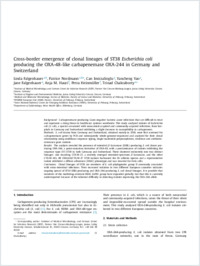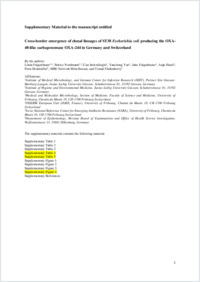Cross-border emergence of clonal lineages of ST38 Escherichia coli producing the OXA-48-like carbapenemase OXA-244 in Germany and Switzerland
- Falgenhauer, Linda Institute of Medical Microbiology, and German Center for Infection Research (DZIF), Partner Site Giessen-Marburg-Langen, Justus Liebig University Giessen, Giessen, Germany - Institute of Hygiene and Environmental Medicine, Justus Liebig University Giessen, Giessen, Germany
- Nordmann, Patrice Medical and Molecular Microbiology, Section of Medicine, Faculty of Science and Medicine, University of Fribourg, Fribourg, Switzerland - INSERM European Unit (IAME, France), University of Fribourg, Fribourg, Switzerland - Swiss National Reference Center for Emerging Antibiotic Resistance (NARA), University of Fribourg, Fribourg, Switzerland
- Imirzalioglu, Can Institute of Medical Microbiology, and German Center for Infection Research (DZIF), Partner Site Giessen-Marburg-Langen, Justus Liebig University Giessen, Giessen, Germany
- Yao, Yancheng Institute of Medical Microbiology, and German Center for Infection Research (DZIF), Partner Site Giessen-Marburg-Langen, Justus Liebig University Giessen, Giessen, Germany
- Falgenhauer, Jane Institute of Medical Microbiology, and German Center for Infection Research (DZIF), Partner Site Giessen-Marburg-Langen, Justus Liebig University Giessen, Giessen, Germany
- M.Hauri, Anja Department of Epidemiology, Hesse Health Office, Dillenburg, Germany
- Heinmüller, Petra Department of Epidemiology, Hesse Health Office, Dillenburg, Germany
- Chakraborty, Trinad Institute of Medical Microbiology, and German Center for Infection Research (DZIF), Partner Site Giessen-Marburg-Langen, Justus Liebig University Giessen, Giessen, Germany
-
01.12.2020
Published in:
- International Journal of Antimicrobial Agents. - 2020, vol. 56, no. 6, p. 106157
English
Background: Carbapenemase-producing Gram-negative bacteria cause infections that are difficult to treat and represent a rising threat to healthcare systems worldwide. This study analysed isolates of Escherichia coli (E. coli), a species associated with nosocomial-acquired and community-acquired infections, from hospitals in Germany and Switzerland exhibiting a slight decrease in susceptibility to carbapenems.Methods: E. coli strains from Germany and Switzerland, obtained mainly in 2019, were first screened for carbapenemase genes by PCR and subsequently whole-genome-sequenced and analysed for their clonal relationship using multilocus sequence typing, single nucleotide polymorphisms, virulence and antibiotic-resistance gene content.Results: The analysis revealed the presence of extended β-lactamase (ESBL)-producing E. coli clones producing OXA-244, a point- mutation derivative of OXA-48, with a predominance of isolates exhibiting the sequence type (ST) ST38 in both Germany and Switzerland. These clustered exclusively into two distinct lineages: one encoding CTX-M-27, a recently emerged extended-spectrum β-lactamase, and the other CTX-M-14b. All OXA244/CTX-M-27 ST38 isolates harboured the Dr adhesin operon and a representative isolate exhibited a diffuse adherence (DAEC) phenotype and was invasive for Hela cells.Conclusion: Clonal lineages of ST38 are members of E. coli phylogenetic group D commonly associated with extra-intestinal infections. Their increased isolation in two different European countries indicates ongoing spread of ST38 ESBL-producing and OXA-244- producing E. coli clonal lineages. It is possible that members of the multidrug-resistant DEAC ExPEC group have expanded globally, but that this is currently underreported because of the inherent difficulty in detecting isolates expressing the OXA-244 allele.
- Faculty
- Faculté des sciences et de médecine
- Department
- Médecine 3ème année
- Language
-
- English
- Classification
- Biological sciences
- License
-
License undefined
- Identifiers
-
- RERO DOC 329958
- DOI 10.1016/j.ijantimicag.2020.106157
- Persistent URL
- https://folia.unifr.ch/unifr/documents/309205
Other files
Statistics
Document views: 135
File downloads:
- pdf: 378
- Supplementary material: 140

